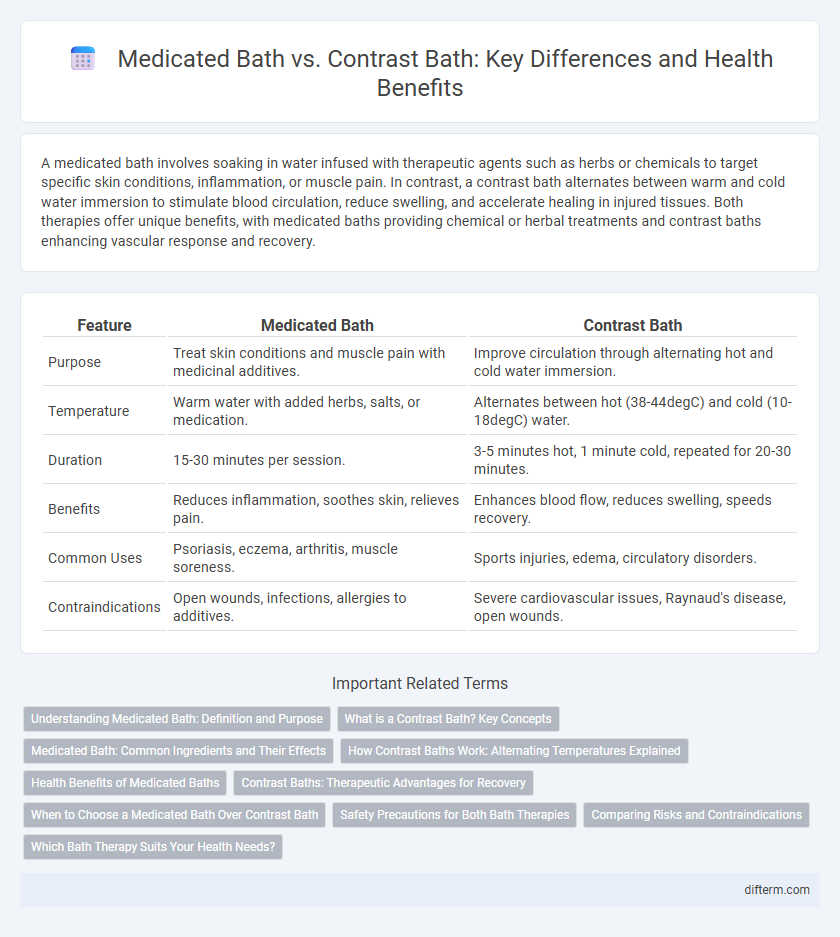A medicated bath involves soaking in water infused with therapeutic agents such as herbs or chemicals to target specific skin conditions, inflammation, or muscle pain. In contrast, a contrast bath alternates between warm and cold water immersion to stimulate blood circulation, reduce swelling, and accelerate healing in injured tissues. Both therapies offer unique benefits, with medicated baths providing chemical or herbal treatments and contrast baths enhancing vascular response and recovery.
Table of Comparison
| Feature | Medicated Bath | Contrast Bath |
|---|---|---|
| Purpose | Treat skin conditions and muscle pain with medicinal additives. | Improve circulation through alternating hot and cold water immersion. |
| Temperature | Warm water with added herbs, salts, or medication. | Alternates between hot (38-44degC) and cold (10-18degC) water. |
| Duration | 15-30 minutes per session. | 3-5 minutes hot, 1 minute cold, repeated for 20-30 minutes. |
| Benefits | Reduces inflammation, soothes skin, relieves pain. | Enhances blood flow, reduces swelling, speeds recovery. |
| Common Uses | Psoriasis, eczema, arthritis, muscle soreness. | Sports injuries, edema, circulatory disorders. |
| Contraindications | Open wounds, infections, allergies to additives. | Severe cardiovascular issues, Raynaud's disease, open wounds. |
Understanding Medicated Bath: Definition and Purpose
A medicated bath involves soaking the body in water infused with therapeutic agents such as essential oils, herbs, or mineral salts designed to relieve specific health conditions like skin irritations, arthritis, or muscle pain. This treatment enhances skin absorption of active compounds, promoting anti-inflammatory, antiseptic, and soothing effects for improved physical well-being. Medicated baths are tailored to individual health needs by varying the ingredients and temperature, optimizing therapeutic outcomes in managing chronic pain and dermatological disorders.
What is a Contrast Bath? Key Concepts
A contrast bath involves alternating immersion of the body part in hot and cold water to stimulate circulation and reduce inflammation. This therapy enhances vascular response by promoting vasodilation during the warm phase and vasoconstriction during the cold phase, accelerating tissue healing. Contrast baths are commonly used to manage muscle soreness, joint pain, and enhance recovery after physical activity.
Medicated Bath: Common Ingredients and Their Effects
Medicated baths commonly include ingredients such as eucalyptus oil, menthol, and herbal extracts like chamomile and lavender, which provide anti-inflammatory, analgesic, and soothing effects on the skin and muscles. These compounds promote relaxation, improve circulation, and reduce muscle stiffness and pain, making medicated baths ideal for conditions like arthritis, muscle soreness, and skin irritations. Unlike contrast baths that alternate water temperatures to stimulate blood flow, medicated baths leverage therapeutic substances to deliver targeted healing benefits through skin absorption.
How Contrast Baths Work: Alternating Temperatures Explained
Contrast baths involve alternating immersion between warm and cold water, typically ranging from 38degC to 44degC for warm and 10degC to 15degC for cold. This temperature alternation stimulates blood circulation by causing vasodilation and vasoconstriction of blood vessels, promoting faster recovery and reducing inflammation. The rhythmic changes in temperature enhance oxygen delivery to tissues and help alleviate muscle soreness more effectively than a medicated bath.
Health Benefits of Medicated Baths
Medicated baths deliver targeted therapeutic effects by infusing water with medicinal herbs and antiseptics that alleviate skin conditions, reduce inflammation, and promote healing. These baths enhance blood circulation and detoxification through prolonged exposure to medicated solutions, supporting overall skin health and immune response. Unlike contrast baths, which alternate temperatures to stimulate circulation, medicated baths provide continuous medicinal absorption, offering sustained relief for chronic dermatological issues.
Contrast Baths: Therapeutic Advantages for Recovery
Contrast baths, involving alternating immersion in hot and cold water, enhance blood circulation and reduce inflammation, accelerating muscle recovery and pain relief. This therapy promotes lymphatic drainage and decreases swelling, supporting faster healing after injury or intense physical activity. Unlike medicated baths, contrast baths rely on temperature variation to stimulate vascular responses without introducing chemicals, making them a natural and effective recovery method.
When to Choose a Medicated Bath Over Contrast Bath
Choose a medicated bath over a contrast bath when targeting localized skin infections, inflammation, or specific dermatological conditions requiring antiseptic or therapeutic agents. Medicated baths deliver direct chemical treatment that soothes symptoms such as eczema, psoriasis, or fungal infections more effectively than temperature-based contrast therapy. Opt for medicated baths in cases needing antimicrobial action or enhanced skin healing, whereas contrast baths primarily improve circulation and reduce swelling.
Safety Precautions for Both Bath Therapies
Medicated baths require careful attention to water temperature and the concentration of medicinal additives to prevent skin irritation or allergic reactions. Contrast baths involve alternating hot and cold water, which demands monitoring of exposure time and temperature to avoid burns or circulatory stress, especially in patients with cardiovascular conditions. Both therapies necessitate consulting healthcare professionals to tailor treatments to individual health conditions and ensure safe application.
Comparing Risks and Contraindications
Medicated baths involve soaking in water infused with therapeutic agents, which may pose risks such as allergic reactions, skin irritation, or systemic absorption of medications, particularly in individuals with sensitive skin or open wounds. Contrast baths alternate between hot and cold water immersion, carrying contraindications like circulatory disorders, deep vein thrombosis, or severe peripheral neuropathy, as rapid temperature changes can exacerbate these conditions. Both therapies require consultation with healthcare professionals to avoid complications linked to underlying diseases or medication allergies.
Which Bath Therapy Suits Your Health Needs?
Medicated baths, infused with therapeutic herbs or essential oils, target specific skin ailments and muscle pain through anti-inflammatory and antiseptic properties. Contrast baths alternate between hot and cold water immersion to improve circulation, reduce swelling, and promote faster recovery from sports injuries or joint stiffness. Choosing between medicated and contrast bath therapy depends on whether you need targeted treatment for skin conditions or enhanced blood flow and muscle rehabilitation.
Medicated bath vs Contrast bath Infographic

 difterm.com
difterm.com